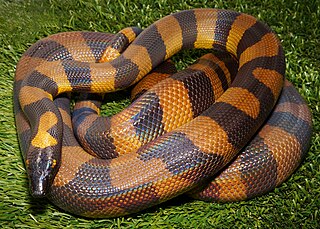
Anomochilus is a genus of snakes, it is the only genus in the monogeneric family Anomochilidae and has three species classified within it. Members of the genus are known as anomochilids, or by the common names dwarf pipesnake, lesser pipesnake, and giant blind snake. Initially created as Anomalochilus in 1890 for the species A. weberi, the genus was renamed in 1901 because the original name was already in use for a genus of beetles. Dwarf pipesnakes are small and cylindrical, with short, conical tails and small, rounded heads that are continuous with the neck. They have blackish to purplish-brown uppersides and dark brown or black undersides, with orange-red bands around the tail and a variety of pale markings on the snout and belly. All three species of dwarf pipesnake are endemic to Sundaland, where they are found on the Malay Peninsula and the islands of Sumatra and Borneo.

Oligodon is genus of colubrid snakes that was first described by Austrian zoologist Leopold Fitzinger in 1826. This genus is widespread throughout central and tropical Asia. The snakes of this genus are commonly known as kukri snakes.

The Bismarck ringed python is a species of snake in the genus Bothrochilus found on the islands of the Bismarck Archipelago. No subspecies are recognized.

Boiga dendrophila, commonly called the mangrove snake or the gold-ringed cat snake, is a species of rear-fanged venomous snake in the family Colubridae. The species is endemic to southeast Asia. It is one of the biggest cat snake species, averaging 8–9 feet in length. It is considered mildly venomous. Although moderate envenomations resulting in intense swelling have been reported, there has never been a confirmed fatality.
Oligodon woodmasoni, the yellow-striped kukri snake, is a species of snake in the family Colubridae. The species is endemic to the Nicobar Islands of India.

Boiga nigriceps is a species of colubrid snake from South-East Asia. They are large snakes; adults may attain a total length of 1.75 m.

Boyd's forest dragon is a species of arboreal lizard in the family Agamidae. The species is native to rainforests and their margins in the Wet Tropics region of northern Queensland, Australia. It is the larger of the two species of Lophosaurus found in Australia. Another species, the southern angle-headed dragon, L. spinipes, is found in southern Queensland and northern New South Wales.
Oligodon calamarius is a species of nonvenomous colubrid endemic to Sri Lanka. It is known as කබර දත්-කැටියා in Sinhala.
Lycodon alcalai, also known commonly as Alcala's wolf snake, is a species of snake in the family Colubridae. The species is endemic to the Philippines.
Lycodon chrysoprateros, also known as Ross's wolf snake, is a species of colubrid snake found on the island of Dalupiri in the Philippines.
Lycodon cavernicolus, also known as Gua Wang Burma wolf snake, is a species of colubrid snake found in peninsular Malaysia. It was first described in 2014.
Oligodon moricei, commonly known as Morice's kukri snake, is a species of snake in the family Colubridae. The species is endemic to southern Vietnam.

Oligodon deuvei is a species of snake in the family Colubridae. The species is endemic to Southeast Asia.
Oligodon ancorus, commonly known as the northern short-headed snake, is a species of colubrid snake found on the islands of Luzon and Mindoro in the Philippines, and the island of Sumatra in Indonesia. However, whether the populations from Sumatra, described as Oligodon rhombifer, belong to this species has been contested.
Oligodon annamensis, commonly known as the Annam kukri snake or Leviton’s kukri snake, is a species of colubrid snake originally known from two specimens from Vietnam, where it was thought to be endemic. It has also since been found in Cambodia and Thailand.

Lycodon ruhstrati, also known as Ruhstrat's wolf snake, the mountain wolf snake, or the Formosa wolf snake, is a species of non-venomous colubrid snake found in Taiwan, southern and eastern China, and northern Vietnam.

Synophis bicolor, known commonly as the bicolored shadow snake or the two-colored fishing snake, is a species of snake in the family Colubridae. The species is endemic to northwestern South America.
Oligodon barroni, Barron's kukri snake, is a species of snake in the family Colubridae. The species is endemic to Southeast Asia.
Oligodon booliati, also known as the Boo-Liat's kukri snake, is a species of snake of the family Colubridae. It is endemic to the Tioman Island, Malaysia. The snake was named for Malaysian zoologist Lim Boo Liat.

Oligodon huahin, the Hua Hin kukri snake, is a species of kukri snakes in the genus Oligodon. The species was first discovered and described in late 2016, and the article was published July 13, 2017. It is only known from its type locality but its range is likely to be more extensive. O. huahin is thought to be very secretive, similar to other species of the genus Oligodon. This theory is supported by the type specimen, which all were males, suggesting that it was found during the mating season where males are out and actively search for females to reproduce. This may also explain why this species had not yet been discovered










